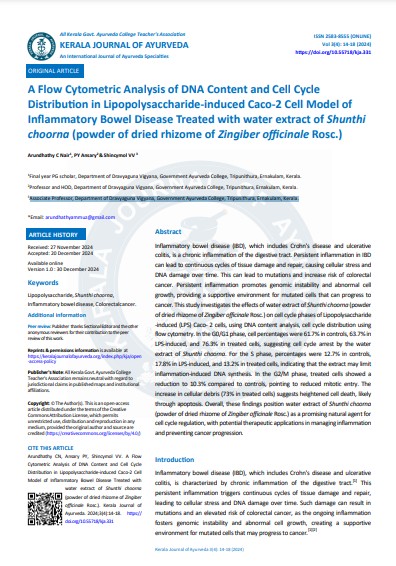A Flow Cytometric Analysis of DNA Content and Cell Cycle Distribution in Lipopolysaccharide-induced Caco-2 Cell Model of Inflammatory Bowel Disease Treated with water extract of Shunthi choorna (powder of dried rhizome of Zingiber officinale Rosc.)
DOI:
https://doi.org/10.55718/kja.331Keywords:
Lipopolysaccharide, Sunthi choorna, Inflammatory bowel disease, Colorectal cancerAbstract
Inflammatory bowel disease (IBD), which encompasses Crohn's disease and ulcerative colitis, is characterized by chronic inflammation of the digestive tract. This persistent inflammation can result in ongoing cycles of tissue damage and repair, which may lead to cellular stress and DNA damage over time. As a consequence, mutations can occur, increasing the risk of colorectal cancer. The sustained inflammation fosters genomic instability and abnormal cell growth, creating an environment that supports the progression of mutated cells toward cancer.This study examines the effects of a water extract of Sunthi choorna (the powdered form of the dried rhizome of Zingiber officinale Rosc.) on the cell cycle phases of Lipopolysaccharide-induced (LPS) Caco-2 cells. The analysis was conducted using DNA content analysis and cell cycle distribution assessed through flow cytometry.
During the G0/G1 phase, the percentage of cells in the control group was 61.7%, in LPS-induced cells was 63.7%, and in treated cells was 76.3%, suggesting cell cycle arrest by the water extract of Sunthi choorna. For the S phase, percentages were 12.7% in controls, 17.8% in LPS-induced, and 13.2% in treated cells, indicating that the extract may limit inflammation-induced DNA synthesis. In the G2/M phase, treated cells showed a reduction to 10.3% compared to controls, pointing to reduced mitotic entry. The increase in cellular debris (73% in treated cells) suggests heightened cell death, likely through apoptosis.
Overall, these findings position water extract of Sunthi choorna (powder of dried rhizome of Zingiber officinale Rosc.) as a promising natural agent for cell cycle regulation, with potential therapeutic applications in managing inflammation and preventing cancer progression.
References
McDowell C, et.al Inflammatory bowel disease. In: StatPearls [Internet]. Treasure Island (FL): StatPearls Publishing; 2024 Jan [updated 2023 Aug 4].
Longo D et al. Harrison’s gastroenterology and hepatology.2nd ed. New Delhi: Mc Graw hill education. P.202-203.17.
Ozkur M, et.al. Ginger for healthy ageing: a systematic review on current evidence of its antioxidant, anti-inflammatory, and anticancer properties. Oxid Med Cell Longev. 2022;2022:4748447. doi:10.1155/2022/4748447
Yucel C, et.al. Immunomodulatory and anti-inflammatory therapeutic potential of gingerols and their nanoformulations. Front Pharmacol. 2022;13:902551. doi:10.3389/fphar.2022.902551
Nunez R. DNA measurement and cell cycle analysis by flow cytometry. Curr Issues Mol Biol. 2001;3(3):67-70.
Jerard C, et.al. Rosmarinic acid-rich fraction from Mentha arvensis synchronizes Bcl/Bax expression and induces G0/G1 arrest in hepatocarcinoma cells. Proc Natl Acad Sci India Sect B Biol Sci. 2019;89(4):1237-45.





